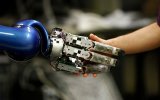Artificial intelligence in minutes put the disabled person on his feet
Computer algorithms have greatly accelerated the adaptation of the people with an amputated leg to the robotic prosthesis. As a result, the start time of the walk has decreased from several hours to minutes. Description of the development published in the journal IEEE Transactions on Cybernetics.

One of the most promising options of modern artificial intelligence is machine learning. In this approach, a computer program automatically tries to solve the problem, thus receiving a “reward” for good results.
News In Russia in 2035 will appear to the University to study robots
In Russia in 2035 will appear to the University to study robots
Based on this principle, the program AlphaZero, which was able to beat the best athletes, the people in the Board game go, and also shows impressive results in other games, such as chess, Dota 2 and Starcraft II.
In the new work, the researchers applied a similar approach to software development for robotic prosthetic legs. The result tested on one patient with an amputated just above the knee limb. Usually such people to travel without assistance you need many hours of training, but also time-consuming setup of denture specialists manually to match the individual nature of the walk.
The new algorithm enabled the disabled to walk on his own after 10 minutes.News Nvidia has taught artificial intelligence to cross pictures of people
Nvidia has taught artificial intelligence to cross pictures of people
Setting of the prosthesis is complicated and includes a selection of 12 parameters that control properties such as stiffness of the knee joint and range of motion when swinging a leg. The algorithm was trained on a relatively small dataset, which were collected with special sensors on the prosthesis for other people with amputated legs.
The authors note that despite the impressive results, the algorithm is still far from a large-scale application, as at the moment designed only for walking on a straight surface. In the future, the researchers intend to add new moves primarily up and down the stairs, test the development on a larger number of people in need.